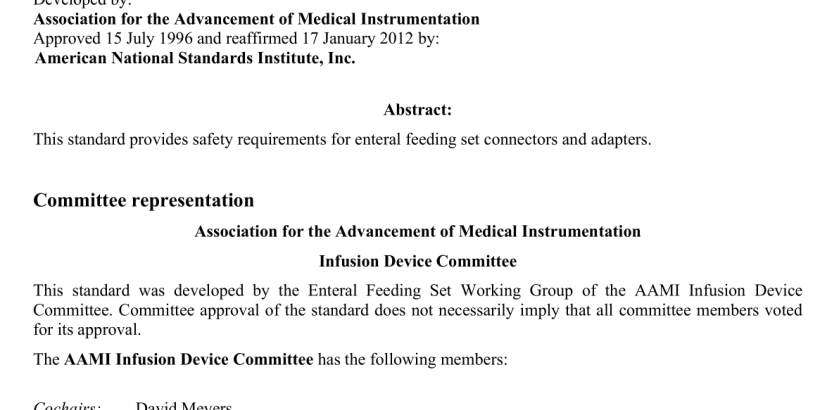ANSI AAMI ID54-1996 pdf download
ANSI AAMI ID54-1996 pdf download Enteral feeding set connectors and adapters
1 Scope
This standard specifies safety requirements for enteral feeding set connectors and adapters.
2 Normative references
The following documents contain provisions which, through reference in this text, constitute provisions of this standard. At the time of publication, the editions indicated were valid. All standards are subject to revision, and parties to agreements based on this standard are encouraged to use the most recent editions of the documents indicated below.
2.1 AMERICAN NATIONAL STANDARDS INSTITUTE. Luer taper fittings and performance, ANSI/HIMA MD 70.1—1983. New York (NY): ANSI, 1983. (Withdrawn.)
2.2 INTERNATIONAL ORGANIZATION FOR STANDARDIZATION. Conical fittings with a 6 percent (luer) taper for syringes, needles and certain other medical equipment—Part One: General requirements, ISO 594/1, Geneva, Switzerland: ISO, 1986.
2.3 INTERNATIONAL ORGANIZATION FOR STANDARDIZATION. Conical fittings with a 6 percent (luer) taper for syringes, needles and certain other medical equipment—Part Two: Lock fittings, ISO 594/2,Geneva, Switzerland: ISO, 1991.
3 Definitions
For the purposes of this standard, the following definitions apply:
3.1 adapter: Separate device, components, integrated fixtures, or other means or mechanisms, which permit a functional connection between two incompatible devices.
3.2 compatible: Allowing a functional connection.
3.3 connector: An integral component of the enteral feeding set that joins the set to the enteral access device.
3.4 enteral feeding: Nutrition support for patients using liquids as a substitute for solid food that involves delivery of nutrient liquids into the alimentary tract (stomach, duodenum, or jejunum) using specialized tubes—including but not limited to nasoenteral, gastrostomy, jejunostomy, or oesophagostomy tubes. Feeding is administered by an enteral pump or gravity.
NOTE–The word “enteral” specifically excludes delivery of liquids into an artery or vein.
3.5 parenteral administration: Delivery of a specialized fluid or medicine specifically and only into a vein or artery; sometimes referred to as “IV” or “intravenous” delivery.
3.6 set: A system that consists of tubing and other components through which fluids are delivered to either an enteral or parenteral access device.
4.1 Elimination of adapters
Adapters that are provided with, or for use with, enteral feeding sets shall not allow the direct or functional connection of an enteral feeding set to a rigid female luer connector. Examples of connections that shall not be possible by use of an adapter include but are not limited to the following:
a) enteral feeding set to a parenteral administration set;
b) enteral feeding set to an indwelling intravenous catheter or port;
c) enteral feeding set to an epidural catheter;
d) enteral feeding set to balloon inflation ports.
4.2 Enteral feeding set connectors
Enteral feeding set connectors shall not be compatible with rigid female luer connectors that meet ANSI/HIMA MD 70.1—1983, ISO 594/1, and/or ISO 594/2.
The purpose of enteral adapters is to provide a means to connect enteral feeding sets to enteral access devices (e.g., jejunostomy tubes), which are constructed with rigid luer taper connectors that meet the American National Standard (now withdrawn), Luer taper fittings and performance (ANSI/HIMA MD 70.1-1983); International Standard Conical fittings with a 6 percent (luer) taper for syringes, needles and certain other medical equipment—Part One: General requirements (ISO 594/1) and/or International Standard Conical fittings with a 6 percent (luer) taper for syringes, needles and certain other medical equipment—Part Two: Lock fittings (ISO 594/2).
These systems are intended to have unique methods of delivery, with distinctly different purposes, which these adapters can circumvent—possibly resulting in harm or serious injury to the patient. In 1993, the AAMI Enteral Feeding Set Working Group began developing this standard in an effort to minimize the possibility of potentially harmful connections occurring between enteral feeding sets and indwelling IV ports, catheters, peritoneal catheters, and tracheostomy tubes. It is intended that this standard will result in changes to the design of enteral feeding sets so that, within 6 months, all new enteral feeding sets will be incompatible with rigid IV female luers.
